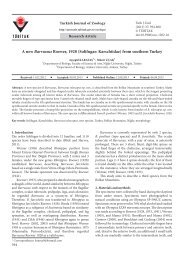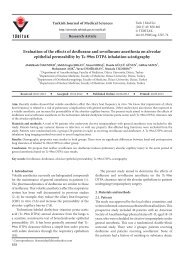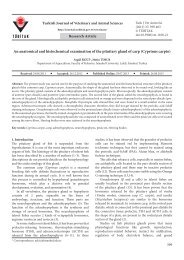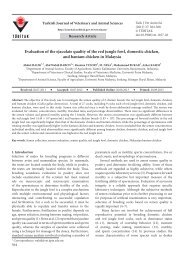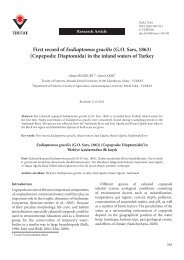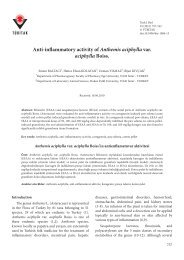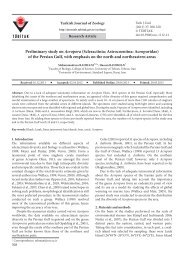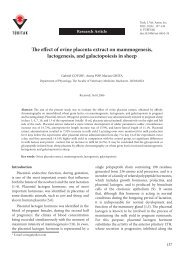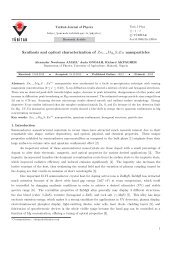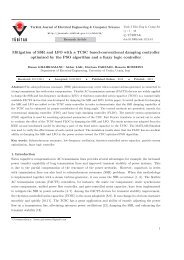yer-17-4-11-0705-4:Mizanpaj 1 - Scientific Journals - Tübitak
yer-17-4-11-0705-4:Mizanpaj 1 - Scientific Journals - Tübitak
yer-17-4-11-0705-4:Mizanpaj 1 - Scientific Journals - Tübitak
You also want an ePaper? Increase the reach of your titles
YUMPU automatically turns print PDFs into web optimized ePapers that Google loves.
Turkish Journal of Earth Sciences (Turkish J. Earth Sci.), Vol. <strong>17</strong>, 2008, pp. 835–845. Copyright ©TÜBİTAK<br />
First published online <strong>11</strong> June 2008<br />
Relative Sea-level Changes of the Lower Cretaceous Deposits<br />
in the Chotts Area of Southern Tunisia<br />
LAZZEZ MARZOUK & MOHAMED BEN YOUSSEF<br />
Laboratoire des Géoressources, Centre de Recherches et des Technologies des Eaux,<br />
Pôle Technologique Borj Cédria, BP 273, 8020, Soliman, Tunisia<br />
(e-mail : lazzez.marzoug@laposte.net)<br />
Abstract: A transition facies between evaporate and clay, carbonate and siliciclastic deposits occurs within the Lower Cretaceous of<br />
Southern Tunisia. The sedimentary deposits comprise four major transgressive-regressive sedimentary sequences with distinctive<br />
sabkha, tidal to shallow carbonate marine platform, and mixed siliciclastic ramp environments. Sedimentation rates, as well as<br />
thickness and facies changes were controlled by tectonic, climatic and eustatic factors. Transgression pulses encompassing the whole<br />
Late Hauterivian–Barremian, Early Aptian and Late Albian have controlled the basin infill. Evaporate and siliciclastic systems pass<br />
gradually to carbonate deposition in the Chotts area. Our sedimentation model helps to decipher the roles of tectonics and, to a lesser<br />
extent, climate and palaeogeographic changes as the key factors of evaporate, carbonate and siliciclastic deposit sequences.<br />
Furthermore, sea level changes exert additional control on their environmental differentiations in such an ancient sedimentary basin.<br />
The sedimentary environments and palaeogegraphy in the Chotts chain during Hauterivian to Albian time are also reconstructed.<br />
Key Words: Lower Cretaceous, depositional environment, palaeogeography, Chotts area, Tunisia<br />
Alt Kretase Çökellerindeki Göreceli Deniz Seviyesi Değişimleri, Chotts Bölgesi, Güney Tunus<br />
Özet: Güney Tunus Alt Kretase birimlerinde evaporit ve kil ile karbonat ve silisiklastik çökeller arasında bir geçiş fasiyesi bulunur.<br />
İstif, belirgin sebka, karışık silisiklastik ramp, ve gelgit ortamından sığ deniz karbonat platformuna kadar değişen ortamları temsil<br />
eden dört farklı transgresif-regresif birimleri içerir. Sedimantasyon oranı, kalınlık ve fasiyes değişimleri, tektonizma, iklim ve östatik<br />
değişimler gibi değişkenler tarafından denetlenmiştir. Geç Hauteriviyen–Barremiyen, Erken Aptiyen and Geç Albian dönemindeki<br />
transgresif olaylar havza dolgusunu kontrol etmiştir. Chotts bölgesinde, evaporitler ve silisiklastik sistemler karbonatlara doğru<br />
dereceli bir geçiş gösterirler. Modelimiz, tektonizmanın rolünü deşifre ederken, daha az oranda da olsa iklim ve paleocoğrafik<br />
değişimlerinde evaporit, karbonat ve silisiklastik çökellerin oluşumunda anahtar değişkenler olduğunu ortaya koymaktadır. Ayrıca, bu<br />
tür eski sedimanter havzalarda deniz sevisyesindeki değişimlerde ortamların farklılaşmasını kontrol eden ilave değişkenler arasında<br />
<strong>yer</strong> almaktadır. Bunlara ilaveten, Hauteriviyen’den Albiyen’e kadar olan dönemi kapsayan zaman dilimi için Chotts bölgesinin<br />
sedimanter ortamları ve paleocoğrafyası da tartışıldı.<br />
Introduction<br />
Anahtar Sözcükler: Alt Kretase, çökelim ortamı, paleocoğrafya, Chotts bölgesi, Tunus<br />
Tunisia is located at the northern edge of North Africa,<br />
bounded by the Mediterranean Sea, Algeria and Libya<br />
(Figure 1). In this region, Late Carboniferous to presentday<br />
sedimentary events were summarised in previous<br />
studies and compilations by De Lapparent (1954) and<br />
more recently by Fakhraoui (1983), Ben Youssef et al.<br />
(1985) and Ben Ismaïl (1991).<br />
The study area is situated in central eastern Tunisia and<br />
shows Mid-Cretaceous deposits comprising carbonates,<br />
marl, clay, sandstone, limestone and dolostone. The latter<br />
extend for over 100 km and include the Northern Chotts<br />
chain, from the Smaïa outcrop in the west, to the east near<br />
Roumana outcrop in the El Meida region and in the<br />
Southern Chotts chain, from Radouane outcrop in the west<br />
to near Khachem Errabib outcrop in the east (Figure 1).<br />
Previous work done by Memmi (1983) and Burollet<br />
(1989) focused either on the stratigraphic or<br />
palaeontologic aspects of the local series and the main<br />
published results show six distinctive changes in<br />
depositional facies. More recently, M’rabet (1987)<br />
proposed a reappraisal of the detailed stratigraphy in<br />
southern Tunisia. The major aims of this paper are: (i) to<br />
reconstruct the depositional environments of sedimentary<br />
sequences in the Chotts area and (ii) to discuss the role of<br />
835
<strong>11</strong>°<br />
10° 30<br />
10°<br />
9° 30<br />
9°<br />
8° 30<br />
8°<br />
836<br />
8° 9° <strong>11</strong>° 37°<br />
Tunis<br />
Tabarka<br />
Tunis<br />
Algeria<br />
Nabeul<br />
Zone tellienne<br />
36°<br />
Tunisia<br />
Aures<br />
Pelagic Sea<br />
Saharian Atlas<br />
Plates<br />
Rebat<br />
sousse<br />
Gafsa<br />
Meseta<br />
ALGERIA<br />
Sfax<br />
Saharan Platform<br />
Gafsa<br />
Southern Atlasique Flexure<br />
200 KM<br />
Study area<br />
Gabes<br />
34°<br />
Study Area<br />
100km<br />
SEDIMENTOLOGY OF LOWER CRETACEOUS IN S TUNISIA<br />
35°<br />
Gafsa<br />
Noual sabkha<br />
J.Orbata<br />
35°<br />
Gafsa fault<br />
Skhira<br />
J.Zemlat J.Zemlat Elbeidha Elbeidha<br />
J. Chemsi<br />
J. Sehib<br />
J. Hadifa<br />
J.Berda<br />
J.Sif Lahami<br />
J.Birom Ali<br />
J.Barrani<br />
t ElHamma sabkha<br />
ElHamma<br />
Gabès<br />
J.Kchem J.Kchem Errabib Errabib<br />
Chott Fejej area<br />
J.Bressef J.Bressef<br />
Negrine Tozeur fault<br />
Djerba<br />
J. J. Foum Foum ElArgoub ElArgoub<br />
J. J. Foum Foum ElHassene ElHassene<br />
ChottJerid area<br />
34°<br />
Djeffara fault<br />
34°<br />
Médenine<br />
8° 8° 30 9° 9° 30 10°<br />
10° 30<br />
<strong>11</strong>°<br />
JurassicN<br />
0 5km<br />
study section<br />
Permian<br />
Trias<br />
Barremian-Aptian<br />
Aptian Aptian-Albian<br />
Mid to Upper Cretaceous<br />
dextral strike-slip fault sinistral strike-slip fault<br />
fold<br />
Figure 1. Geological sketch map 500.000 (Ben Haj et al.1985, modified scale) of the Chott Area, and location map of study area showing position of section<br />
locality referred to in the text. Zemla El Beidha, Bir Om Ali, Khchem Errebib and Foum El Argoub sections.
either eustatic and/or tectonic as the controlling factors of<br />
Mid-Cretaceous sedimentation at the transition between<br />
the southern flat-lying Saharan platform and the northern<br />
Atlas domain.<br />
Geological Setting<br />
Cretaceous<br />
The Early Cretaceous comprises complex deltaic deposits<br />
derived from the northern Sahara and shallow marine<br />
facies nearer the Chotts chain in the south of Tunisia. The<br />
Barremian–Aptian in central and South Tunisia is<br />
characterized by carbonate and detrital deposits. Facies and<br />
thickness variation are controlled by structural factors<br />
associated with halokinesis events, which seem to play a<br />
major role in sedimentary deposition (Pervinquière 19<strong>11</strong>;<br />
Bismuth et al. 1967; Khessibi 1978; Burollet & Busson<br />
1983; Abbes et al. 1986; Chikaoui et al. 1991; Chaabani<br />
1994; Ben Youssef 1998; Ouajaa 2003; Srarfi 2006).<br />
During the early Albian stage, a large part of Tunisia<br />
(Saharan platform, Djeffara, central and eastern Tunisia)<br />
was emergent. Only the northern part of Tunisia, the<br />
Chotts chains in the south of Tunisia and the Gafsa basin<br />
have a continuous sedimentary record during the Albian.<br />
The Cretaceous carbonate facies of this zone generally<br />
change from a subcontinental domain in the Sahara<br />
Platform to a marine domain in the Chotts chain in<br />
southern Tunisia. The N120° and Negrine Tozeur faults<br />
mark the limit between the Tunisian Atlas and the Saharan<br />
Platform (Zouari 1995; Bédir et al. 2001) and controlled<br />
the structure of the Chotts chains. The Tertiary<br />
compressional movements strongly affected all the Lower<br />
Cretaceous basement which underlies the area, and<br />
especially near the Chotts chain, where Lower Cretaceous<br />
folding on NW–SE and E–W axes may reflect the wrinkled<br />
structure of the study area (Figure 2) (Abdeljaoud 1983;<br />
Zargouni 1985; Abdallah & Rat 1987; Chaabani et al.<br />
1992; Boukadi 1994; Bouaziz et al. 2002; Bédir et al.<br />
1992; Zouaghi et al. 2005).<br />
Sequences, Facies, and Deposit Environment<br />
The Lower Cretaceous rocks of southeastern Tunisia<br />
consist of four major transgressive-regressive sedimentary<br />
sequences, identified by sea level, lithology and their<br />
biostratigraphic content changes. Each sedimentary<br />
sequence is bounded by an emersion surface (Figures 3A,<br />
B & 4).<br />
L. MARZOUK & M. B. YOUSSEF<br />
Sequence I (Bouhedma: Upper Hauterivian)<br />
Lithology and Lateral Evolution<br />
This sequence is considered to be late Hauterivian age<br />
(Busson 1967; Peybernes et al. 1985) and consists of an<br />
alternating sequence of anhydrite, limestones and<br />
claystones. They have pack-grainstone textures and often<br />
contain abundant bioclastic debris (bivalves). This sequence<br />
is composed of repetitive mixed carbonate-clay-evaporate<br />
cycles (Figure 3C). Each cycle, less than 10 m in thickness<br />
and called an elementary sequence, starts with carbonate<br />
(0.5 m) and occasionally with shale. The carbonates<br />
generally consist of laminated dolomites also exhibiting<br />
dome-shaped stromatolites. Within the upper part of the<br />
Bouhedma formation, the clays have a thickness varying<br />
from 13 to 20 m. The top is predominantly gypsum with<br />
anhydrite beds having a thickness varying from 0.5 to 0.8<br />
m. Gypsum beds are laminated and may exhibit chicken<br />
wire and porphyroblastic structures (Figure 3D). The base<br />
of this sequence is characterized by basal limestone up to<br />
2 m thick which may be replaced by laminated, poorly<br />
bioclastic fine dolomites. Petrological study reveals the<br />
presence of dissolved micronodules of gypsum with blocky<br />
calcite fill. These features suggest that the brecciated<br />
dolomites resulted from dissolution of former associated<br />
evaporates and not from tectonic instability, as postulated<br />
by M’rabet (1987). The basal part of the breccias is locally<br />
marked by stromatolitic laminations.<br />
Depositional Environment<br />
The first sequence deposits correspond to a shallow marine<br />
carbonate platform formed in a subaqueous evaporitic<br />
environment. The very thick anhydrite section logged with<br />
dolomite and limestone, which is over 30 m thick, records<br />
a long period of supratidal to evaporitic sabkha deposition.<br />
The clay-evaporates which are over 15 m thick, include<br />
laminated subaqueous gypsum. The petrology of the<br />
limestone is typical of a shallow marine shelf, inner to<br />
marginal environment where continental influences are<br />
increasing. This sequence is characterized by the absence of<br />
foraminifera. However, a lower proportion of<br />
lamellibranchs and bioclasts of the bivalves was observed<br />
(Figure 4).<br />
Sequence II (Sidi Aich Barremian)<br />
Lithology<br />
These sequences are composed of shaly sands and<br />
ferruginous sandstones. These sandy bodies are generally<br />
837
8°<br />
Negrine<br />
Tozeur Fault<br />
lenticular, up to 3 m thick and have a sequence repetition.<br />
Above, most of the sequence consists of sandy to shaly<br />
coarsening-upwards sequences exhibiting crossstratification,<br />
indicating fluvial transport. Wood debris is<br />
locally present. These coarsening-up sequences are<br />
intercalated with decimetric silt claystone or sands<br />
exhibiting current ripples. This sequence, characterized by<br />
lenticular sand bodies up to 2 m thick, has an erosive base<br />
and exhibits planar cross stratification, indicating transport<br />
from southwest to northeast. Laterally extensive fine- to<br />
838<br />
0 20 km<br />
Northern Atlasic Domain<br />
J. Bouhlel<br />
8° 30<br />
CHOTTJERID AREA<br />
Northern range of the Chotts<br />
Tozeur<br />
first-order fault<br />
second order Fault<br />
J. Torrich<br />
SEDIMENTOLOGY OF LOWER CRETACEOUS IN S TUNISIA<br />
9°<br />
Gafsa Fault<br />
J. ElHamra<br />
Gafsa<br />
CHOTT FEJEJ AREA<br />
Southern range of the Chotts<br />
J. Radouane<br />
fold axis<br />
reverse fault<br />
J. Sif Lham<br />
J. Foum ElHassene<br />
Om Ali Fault<br />
J.Bir Om Ali<br />
J.BarraniJ. Hadifa<br />
dextral strike-slip fault<br />
sinistral strike-slip fault<br />
J. Foum Le<br />
Argoub<br />
Figure 2. Tectonic setting showing the main outcrop lineaments in Southern Tunisia (Fakhraoui 1990).<br />
9° 30<br />
10°<br />
ElHamma Sabkha<br />
10° 30<br />
Lefaïa<br />
Fold<br />
Hadifa<br />
Fold<br />
J.Bressef<br />
J.Kchem<br />
Errebib<br />
Mediterranean sea<br />
ElHamma<br />
medium-grained cross-bedded sandstones and fining-up<br />
units occur in the channels. They contain large numbers of<br />
silicified wood fragments.<br />
The cross-bedded sandstone facies (Figure 3E, F) is<br />
composed of thick sandstone channels associated laterally<br />
with typical silt claystone beds. The channels are generally<br />
4–6 m thick, but may exceed 10 m in thickness, and are<br />
laterally extensive. They are generally coarse grained, often<br />
with clay rip-up clasts, and contain large channel crossbeds.<br />
N<br />
J. Zemla Le Beidha<br />
synclinal axis<br />
<strong>11</strong>°<br />
35°30<br />
35°<br />
34 °30
L. MARZOUK & M. B. YOUSSEF<br />
A B<br />
NG<br />
C WF<br />
D<br />
WF<br />
NG<br />
E F<br />
SII<br />
SI<br />
PS<br />
CS<br />
Figure 3. Field views of some particular segments of Lower Cretaceous sections. (A, B) general view of the typical Bouhedma<br />
clay (SI) overlain by the Sidi Aïch sandstones (SII), and the Orbata carbonates (SIII) and the Zebbag Shaly limestone<br />
(SIV). Hauterivian to Albian, Zemla El Beidha section; (C) thin-bedded calcareous sandstones or siltstones with evaporate<br />
containing bivalves and intraclasts, sequence I; (D) Laminated gypsum associated with nodular gypsum and<br />
porphyroblastic structure (NG– nodular gypsum), Sequence I, Hauterivian, El Hamra section; (E) Large numbers of<br />
silified wood fragments (WF– wood fragments), Sequence II, Barremien, Foum El Argoub section; (F) planar and<br />
cross stratification (CS) in the sandstone (PS– planar stratification), Sequence II, Barremian, Bir Oum Ali section.<br />
CS<br />
PS<br />
SIV<br />
SIII<br />
839
840<br />
Age<br />
Upper Albian<br />
APTIAN (Bedoulian - Gargasian)<br />
Barremian<br />
Hauterivian<br />
Formations<br />
Zebbag<br />
Orbata<br />
Sidi Aïch<br />
Bou Hedma<br />
Member<br />
SEDIMENTOLOGY OF LOWER CRETACEOUS IN S TUNISIA<br />
Lithology<br />
Bioclasts<br />
Ammonits<br />
Orbitolina<br />
Ostracod<br />
Benthic<br />
Foraminifèra<br />
sandstone dolomite limestone marl<br />
clay<br />
Ammonite<br />
Foum Le Argoub<br />
Barrani<br />
oolitic<br />
limestone<br />
bioclastic<br />
limestone<br />
Echinoderm<br />
Rudists<br />
Lamellibranche<br />
benthic Foraminifera<br />
Bioturbation<br />
Oolithic<br />
Wood Debris<br />
Cross<br />
Stratification<br />
unconformities<br />
gypsum<br />
Environment<br />
- +<br />
Figure 4. Synthetic biostratigraphic column of Hauterivian–Albian sequences in the Chotts region.<br />
15 m<br />
Sedimentary<br />
Sequence<br />
S1 S2 S3<br />
S4
Depositional Environment<br />
Cross-bedded sandstone and fining-up parasequences<br />
characterize a fluvial environment. Large fluvial channels<br />
represent major meandering rivers which were outlined by<br />
channel lags, pebbles and wood fragments (Figure 3C, D).<br />
The sandstones and siltstones are well sorted, with<br />
subangular to subrounded quartz grains. Cementation is<br />
poor, with patchy siliceous and dolomitic cement (Figure<br />
5D). The ferruginous sandstones and the siltstones suggest<br />
a fluvial environment.<br />
Sequence III (Orbata: Aptian)<br />
Lithology<br />
In the northern part of the Chott Fedjedj area, the Barrani<br />
and Bir Oum Ali outcrops provide a composite section of<br />
the Orbata Formation, showing three members: a lower<br />
member, the Barrani dolomite, with middle horizons of<br />
limestone and marl at its base, rich has a fauna of<br />
Echinoids, Rudists and foraminifera indicating a Late<br />
Barremian and Bedoulian age (Figure 5B, C). A thick middle<br />
member, made up of interbedded often dolomitic<br />
limestone, and marl, grades up and laterally to evaporate<br />
in the upper part; Choffatella decipiens, Orbitolina parva,<br />
Cylindroporella sugdeni, etc. suggest a Bedoulian to<br />
Gargasian age (Figure 4).<br />
The upper member is made up of marl, sand and<br />
calcarenites, capped with a bank of limestone containing<br />
Rudists, and foraminifera, including Orbitolina parva; and<br />
Mesorbitolina texana, etc. In the sand-shale member,<br />
ammonites were found, including Deshaysites callidiscus,<br />
D.cf. planus, D. weissi, D. furcata, Valdorsella sp. and<br />
fragments of chelonicertidae. This fauna is middle<br />
Bedoulian to Gargasian in age. The top of this upper<br />
member is eroded and there is sand and gravel at the base<br />
with 1.5 m of overlying sandy clay. They represent the top<br />
of the Orbata formation, which is dated as Gargasian by<br />
Foraminifera (orbitolina minuta, Orbitolina texana and<br />
paracoskinolina tunesiana) (Figure 4).<br />
South of the Chott Fedjedj, at Foum El Argoub section,<br />
this formation is thinner. The upper member has been<br />
eroded by scouring beneath a coarse-grained gravel and<br />
sand unit, with fossil wood remains.<br />
The lower part of the Orbata formation is composed<br />
of massive dolomites (Busson 1967; Ben Youssef et al.<br />
1984; Kamoun 1988) which are finely to medium<br />
crystalline and often show relict sedimentary textures.<br />
L. MARZOUK & M. B. YOUSSEF<br />
Most of sequence III (25–40 m thick) consists of locally<br />
bioclastic dolomites, overlain by mud-wackestones<br />
containing ostracods and some bioturbation. Carbonates<br />
are mostly preserved as limestones characterized by several<br />
textures and components. The following microfacies were<br />
observed.<br />
The Bedoulian microfacies, is represented by micrites<br />
with fragments of rudists (Figure 5B). The crystallized<br />
dolomites derived from biomicrosparites with echinoids<br />
and oolites and slightly marly micrites with abundant<br />
Orbitolina lenticularis and rare verneuilinids that have been<br />
observed in the Upper Aptian of the Bir Oum Ali and Hamra<br />
outcrops (Figure 5E, F).<br />
In the Hamra outcrop, microfacies are represented by<br />
finely porous micrites with rare small foraminifera such as<br />
ophthalmidids and polymorphinids, or micrites with<br />
ostracods and polymorphinids. Only a major regressive<br />
episode is marked by erosion at the base of the giant crossbedded<br />
sandstone sequence of Foum El Argoub. These<br />
sequences, which have been observed in the Upper Aptian<br />
(Gargasian) in many sections of the Chotts chain (Bishop<br />
1975, 1988; Ben Youssef et al. 1984; Zargouni & Biely<br />
1986) contain abundant terrestrial invertebrate trace<br />
fossils and accumulations of fossil wood (Figure 3C). As<br />
observed above, sandstones with subangular to<br />
subrounded quartz grains, on the upper Foum El Argoub<br />
outcrop suggest strong detrital influences and channel<br />
deposits.<br />
Depositional Environment<br />
Within Sequence III, the basal Orbata formation contains<br />
shallow marine deposits including metric mixed cycles of<br />
subtidal shales or bioclastic dolomites passing upwards to<br />
intertidal algal mats and then to supratidal or sabkha<br />
environments. The upper part of the Orbata formation<br />
reflects a slight but clear marine deepening and renewed<br />
transgression. Within the upper part of this formation<br />
these deepening marine environments revert to a very<br />
shallow marine platform lacking shale: sands are organized<br />
in a succession of coarsening- and thickening-upwards<br />
sequences. The sands are associated with intercalations of<br />
evaporates and laminated dolomites. This environment<br />
became shallower and was influenced by fluvio-marine<br />
siliciclastics derived from the Sahara Platform. This<br />
terrigenous influence becomes more and more important,<br />
ushering in the southern Chotts fluvial complex<br />
sedimentation.<br />
841
842<br />
SEDIMENTOLOGY OF LOWER CRETACEOUS IN S TUNISIA<br />
A B<br />
O<br />
C D<br />
E<br />
E F<br />
CD<br />
O<br />
Q<br />
Q Q<br />
Figure 5. Photomicrographs of selected samples in the Lower Cretaceous section (white bar is the scale: 0.5 mm<br />
and valid for all photographs): (A) oolitic pack-grainstone including bioclastic fragments (O– oolite),<br />
sequence IV, Albian, Khachem Errebib section; (B) micrites with fragments of rudists and gasteropods<br />
(G– gasteropods), sequence III, Bedoulian, Bir Oum Ali section; (C) biomicrosparites with echinoderm<br />
debris, (E– Echinodermata), sequence III, Bedoulian, Bir Oum Ali section; (D) the Foum El Argoub<br />
sandstone composed by quartzarenite with cement characterized by fine dolomite rhombs average 20<br />
μm in diameter (Q– Quartz, D– dolomite rhombs), sequence III, Gargasian, Foum El Argoub section;<br />
(E) wacke-mudstone with abundant ostracods benthic foraminifera (CD– Chaffotella Decipiens),<br />
sequence IV, Albian, Bir Oum Ali section; (F) marly micrites with benthic foraminifera (MO–<br />
Mesorbitolina orbitolina minuta), sequence III, Aptian, Bir Oum Ali section.<br />
D<br />
Q<br />
Q<br />
G<br />
MO
Sequence IV (Lower Zebbag: Albian)<br />
Lithology<br />
In continuity with the late Aptian regressions, clear low sea<br />
level stands at the beginning of the Albian, and tectonic<br />
factors caused a general lack of sedimentation in central<br />
and Southern Tunisia (Ben Youssef & Peybernes 1986).<br />
The fourth sequence averages 90 m in thickness and<br />
corresponds to the lower part of the Zebbag formation<br />
(Busson 1967). This sequence starts with hard limestones<br />
with a clear erosive base which locally contain reworked<br />
micritic clasts from the underlying sequence III (Figure 4).<br />
This carbonate-rich sequence contains significant fossils<br />
(ammonites [Knemiceras cf gracile, Knemiceras. Gr.<br />
Compressum], nautiloids, echinoids, brachiopods)<br />
indicating an late Albian age (Arnauld 1956). These<br />
carbonates are intercalated with fossiliferous marls. They<br />
have pack-grainstone texture and contain abundant oolites<br />
(Figure 5A), lithoclasts, foraminifera, gasteropods, and<br />
echinoids (Figure 5B, C). Micrite content increases upwards<br />
and the limestone textures progressively change from<br />
pack-grainstone to wacke-mudstone; within the latter, the<br />
fauna decreases in diversity and abundance and the<br />
uppermost beds contain only brachiopods and rare<br />
foraminifera (Figure 5E).<br />
Depositional Environment<br />
In the Chotts region, the Zebbag formation, clearly<br />
transgressive, reflects mixed marl-carbonate ramp<br />
sedimentation. The lower part of this formation, with<br />
prograding distal bars, suggests a progressive deepening of<br />
the marine environment. This deepening, also confirmed<br />
by the overlying ammonites, nautiloids and echinoids rich<br />
limestones, represents the maximum of the transgression<br />
initiated during the Late Albian.<br />
The basal echinoids and brachiopod-rich shale part<br />
reflects an acceleration of the marine deepening started at<br />
the base of the Zebbag formation. The associated<br />
fossiliferous carbonate intercalations also suggest deep<br />
marine conditions.<br />
Discussion of Sedimentation Controls<br />
The lateral and vertical evolution of Hauterivian–Albian<br />
thicknesses and facies, and hence, of their corresponding<br />
environments in southwestern Tunisia, indicate two distinct<br />
palaeogeograpic zones, whose sedimentary characteristics<br />
L. MARZOUK & M. B. YOUSSEF<br />
remain relatively homogeneous during the Late Cretaceous.<br />
A resistant slowly subsiding and relatively very shallow<br />
marine platform in the south Chotts (Kebili area) and the<br />
Gafsa area was characterized by a progressive subsidence<br />
towards the North.<br />
In summary, Lower Cretaceous sedimentation in<br />
southwestern Tunisia was controlled by E–W and N120º<br />
fault systems most probably inherited from Late Palaeozoic<br />
to Early Mesozoic rifting between the African and<br />
European plates (Bouaziz et al. 2002). This structure also<br />
represents a major feature of the transition, within the<br />
North African margin, between the stable Saharan platform<br />
basin and the less stable Tethyan basins in central and<br />
northern Tunisia.<br />
Climatic control indicators include the gypsum and<br />
carbonate sedimentation, particularly observed within the<br />
Hauterivian to Albian sediments (Bouhedma, Sidi Aïch,<br />
Orbata and lower Zebbag), which indicate an arid<br />
palaeoclimate in southern Tunisia during this period. The<br />
overlying Barremian siliciclastics, locally rich in wood<br />
debris, may suggest climatic evolution to more humid<br />
conditions. However, these siliciclastic deposits are often<br />
intercalated with carbonates (locally rich in oolites), which<br />
imply a temporary pause in terrigenous input and,<br />
consequently, may reflect somewhat semi-arid conditions.<br />
In addition, the arid climate has favoured, in both areas,<br />
the close association of carbonate and siliciclastic<br />
sediments. The Lower Cretaceous deposits of southern<br />
Tunisia correspond to four transgressive-regressive<br />
sequences. The transgressive episodes occurred during the<br />
Hauterivian–Barremian, Bedoulien–Gargasian and Late<br />
Albian–Vraconian intervals. These transgressions have been<br />
recognised in central and northern Tunisia and induced<br />
subtidal carbonate sedimentation (Fakhraoui 1983; Ben<br />
Youssef et al. 1985). Such transgressions caused a general<br />
opening and increasing subsidence of the marine<br />
environments in the Chotts regions. The Barremian<br />
regression is followed by a transgression in the Bedoulian.<br />
The latter illustrates a return to near-shore shallow marine<br />
conditions, perhaps influenced by a local lagoonal or tidal<br />
environment. This period is characterized by regressive<br />
deposits which consist of evaporite and siliciclastic<br />
successions (Lefranc & Guiraud 1990). Sea-level rise<br />
induced the deposition of coarsening- to fining-upward<br />
Albian sequences. In addition to transgressive pulses,<br />
tectonic tilting may also be indicated in southeastern<br />
Tunisia (M’rabet 1987; Ghanmi & Potfaj 1991; Ben<br />
Youssef 1998).<br />
843
Conclusions<br />
The Lower Cretaceous deposits record four transgressiveregressive<br />
sequences. Sea-level changes and climatic<br />
conditions recorded an evolution from carbonate tidal flats<br />
to sabkha and a closed evaporitic basin. A shallow marine<br />
platform is indicated by the distribution of facies, high<br />
faunal diversity and sedimentary structures. Transgressive<br />
periods during the Late Hauterivian, Bedoulian and Albian<br />
are related to marine invasion and an increasing subsidence<br />
rate.<br />
These vertical and lateral transitions of environment<br />
systems were also largely controlled by tectonic activity.<br />
References<br />
ABBES, C.H., ABDELJAOUAD, S. & BEN OUEZDOU, H. 1986. Carte Géologique<br />
d'El Hamma au 1/100.000. Institut National de recherche<br />
Scientifique de Tunisie et Service Géologique Nationale d’Office<br />
Nationale de Mines Tunisie.<br />
ABDALLAH, H. & RAT, P. 1987. Le rôle de la faille de Gafsa dans le jeu<br />
transgressif et régressif au Crétacé supérieur de la Chaîne Nord des<br />
Chotts (Tunisie). Extrait de Mémoire Géologique Université de Lyon<br />
(France), 233–242.<br />
ABDELJAOUD, S. 1983. Etude Stratigraphique, Sédimentologique et<br />
Structurale de l'extrémité orientale de la Chaîne des Chotts. Thèse<br />
de 3 ème Cycle, Tunis.<br />
ARNOULD, S. 1956. Contribution a l’Etude des Enganocératidae (les couches<br />
à knémiceras de sud tunisien). Annale Géologique de Mines de Tunis<br />
20, 47, p. 12.<br />
BÉDIR, M., BOUKADI, N., TLIG, S., BEN TIMZAL, F., ZITOUNI, L., ALOUANI, R.,<br />
SLIMANE, F., BOBIER, C. & ZARGOUNI, F. 2001. Subsurface Mesozoic<br />
basins in the central atlas of Tunisia, tectonics, sequence deposit<br />
distribution and hydrocarbon Potential. American Association of<br />
Petroleum Geologists Bulletin 85, 885–907.<br />
BÉDIR, M., ZARGOUNI, F., TLIG, S. & BOBIER, C. 1992. Subsurface<br />
geodynamics and petroleum geology of transform margin basins<br />
in the Sahel of Mahdia and El Jem (Eastern Tunisia). American<br />
Association of Petroleum Geologists Bulletin 76, 14<strong>17</strong>–1442.<br />
BEN HAJ, A.M., JEDOUI, Y., DALI, T., BEN SALEM, H. & MEMMI, L. 1985. Carte<br />
Géologique de la Tunisie 1/500000. Office Nationale des Mines;<br />
service géologique nationale.<br />
BEN ISMAÏL, H.1991. Les Bassins Mésozoïque (Trias à Aptien) du Sud de la<br />
Tunisie: Stratigraphie intégrée, caractéristiques Géophysiques et<br />
Evolution Géodynamique. Thèse Doctorat D’Etat. Faculté de<br />
Sciences de Tunis. Université de Tunis II.<br />
BEN YOUSSEF, M. 1998. Stratigraphie génétique du Crétacé de la Tunisie ;<br />
Micropaléontologie, Stratigraphie Séquentielle et Géodynamique<br />
des bassins de la marge sud et péri Téthysienne. Thèse de Doctorat<br />
D’Etat. Faculté de Sciences de Tunis Université de Tunis II.<br />
844<br />
SEDIMENTOLOGY OF LOWER CRETACEOUS IN S TUNISIA<br />
The rapid lateral facies changes are mainly controlled by<br />
major lineaments that separate areas corresponding to<br />
tilted blocks, each characterized by a distinct local<br />
environment.<br />
Acknowledgements<br />
The authors are grateful to Said Tlig, Taher Zouaghi,<br />
Amara Masrouhi, Moez Ben Fadhel and Mokhtar Fakhraoui<br />
for their invitation to contribute this volume and for their<br />
scientific helpful discussions. John A. Winchester edited<br />
English of the final text.<br />
BEN YOUSSEF, M., BIELY, A., KAMOUN, Y. & ZOUARI H. 1984. Nouvelles<br />
données sur l'Aptien et l'Albien dans la région de Médenine (Tunisie<br />
méridionale). 10 ème Association of <strong>Scientific</strong> and Technical Research,<br />
Bordeaux, p. 51.<br />
BEN YOUSSEF, M., BIELY A., KAMOUN, Y. & ZOUARI, H. 1985. L'Albien moyen<br />
supérieur à Knémiceras forme la base de la grande transgression<br />
crétacée au Tebaga de Médenine. Compte Rendu d’Académie de<br />
Sciences de Paris 300, 965–968.<br />
BEN YOUSSEF, M. & PEYBERNES B. 1986. Données micropaléontologiques et<br />
biostratigraphiques nouvelles sur le Crétacé inférieur marin du Sud<br />
tunisien. Journal of African Earth Sciences 5, 2<strong>17</strong>–231.<br />
BISHOP, W.F. 1975. Geology of Tunisia and Adjacent Parts of Algeria and<br />
Libya. American Association Petroleum Geologists Bulletin 59, 413–<br />
450.<br />
BISHOP, WF. 1988. Petroleum Geology of East-Central Tunisia. American<br />
Association Petroleum Geologists Bulletin 2, 1033–1058.<br />
BISMUTH, H., BONNEFOUS, J. & DUFAURE, Ph. 1967. Mezozoic Microfacies of<br />
Tunisia. Petroleum Exploration Society of Libya, Guide Book to the<br />
Geology and History of Tunisia, 159–214, Tripoli.<br />
BOUKADI, N. 1994. Structuration de l'Atlas de Tunisie : Signification<br />
géométrique et cinématique des noeuds et des zones d'interférences<br />
structurales au contact de grands couloirs tectoniques. Thèse<br />
Doctorat D’Etat. Faculté de Science de Tunis. Université de Tunis II.<br />
BOUAZIZ, S., BARRIER, E., SOUSSI, M., TURKI, M.M. & ZOUARI H. 2002.<br />
Tectonic evolution of the northern African margin in Tunisia from<br />
paleostress data and sedimentary record. Tectonophysics 357,<br />
227–253.<br />
BUROLLET, PF. 1989. Les évènements du Crétacé moyen au Sud de la<br />
Méditerranée. In Colloque, les évènements de la partie moyenne du<br />
Crétacé (Aptien à Turonien). Géobios, Mémoire Spécial <strong>11</strong>, 69–81.<br />
BUROLLET, P.F. & BUSSON, G. 1983. Plateforme Saharienne et Mésogée au<br />
cours du Crétacé. Notes Mémoires de la Compagnie Française de<br />
Pétroles 18, <strong>17</strong>–26.
BUSSON, G. 1967. Le Mésozoïque Saharien. 1 ère partie : l'Extrême Sud<br />
Tunisien. Centre Recherche Zones Arides, services Géologique, n°<br />
18, p. 194, Edition Centre Nationale de Recherche Scientifiques.<br />
CHAABANI, F. 1994. Variations Sédimentaires sous contrôle Tectonique<br />
durant le Sénomanien supérieur au niveau de la passe de Chemsi<br />
(Tunisie centro-méridionale): Cadre océanographique et<br />
implications paléogéographiques. In: The Proceedings of the 4th<br />
Tunisian Petroleum Exploration Conference, Tunis, May 1994,<br />
Entreprise Tunisienne d’Activités Pétrolières, 443–457.<br />
CHAABANI, F., TURKI, M.M. & GARGOURI-RAZGALLAH, S. 1992. L'Aptien à l'Est<br />
de Gafsa. Etude biostratigraphique, sédimentologique et cadre<br />
géodynamique. Notes Service Géologique de Tunis 59, 43–57.<br />
CHIKAOUI, M., TURKI M.M. & DELTEIL, J. 1991. Témoignages de la<br />
structurogenèse de la marge téthysienne en Tunisie, au Jurassique<br />
terminal -Crétacé (Région du Kef, Tunisie septentrionale). Géologie<br />
Méditerranéenne. Tome XVIII 3, 125–133.<br />
DE LAPPARENT, AF. 1954. Les Gisements Cénomaniens de la falaise du<br />
Dahar (extrême Sud tunisien). Notes du Service Géologique de<br />
Tunisie, 5–7.<br />
FAKHRAOUI, M. 1983. Etude Stratigraphique et structurale des Chaînes des<br />
Chotts : Evolution Géométrique et Cinématique liée à l'accident Sud-<br />
Atlasique. Thèse 3ème Cycles. Université de Tunis. 243 p.<br />
FAKRAOUI, M. 1990. Carte Géologique au 1/100 000 ème de la Tunisie.<br />
Feuille n° 73. Bir rakeb, Service Géologique de la Tunisie.<br />
GHANMI, M. & POTFAJ, M. 1991. Données Stratigraphiques sur la Chaîne<br />
de Tebaga de Kebili Jebel Aziza (Tunisie méridionale) :<br />
Conséquences Paléogéographiques et Tectoniques. Notes du Service<br />
Géologique Tunisie 58, 21–28.<br />
KAMOUN, F. 1988. Le Jurassique du Sud-tunisien, témoin de la marge<br />
Africaine de la Téthys: Stratigraphie, Sédimentologie et<br />
Micropaléontologie. Thèse doctorat de 3ème Cycle. Université Paul<br />
Sabatier. Toulouse.<br />
KHESSIBI, M. 1976. Observations Géologiques dans le Jebel Kebar<br />
Mouvements tectoniques anté Cénomanien. Notes Service<br />
Géologique Tunisie 42, 21–27.<br />
LEFRANC, J.P.H. & GUIRAUD, R. 1990. The Continental intercalaire of<br />
Northwestern Sahara its equivalents in the neighbouring regions.<br />
Journal of African Earth Sciences 10, 27–77.<br />
L. MARZOUK & M. B. YOUSSEF<br />
M’RABET, A. 1987. Stratigraphie, sédimentation et diagenèse carbonatée<br />
des séries du crétacé inférieur de Tunisie centrale. Thèse de<br />
Doctorat D’Etat. Faculté de Science de Tunis. Université de Tunis.<br />
MEMMI, L. 1983. Age des Couches à Knemiceras de Foum El Argoub,<br />
Ragoubet Zirzaou et Oued Zitoun. Rapport paléontologique. Service<br />
Géologique National de Tunisie, Rapport inédit S-69.<br />
OUAJAA, M. 2003. Etude Sédimentologique et Paléobotanique du<br />
Jurassique Moyen – Crétacé Inférieur du Bassin de Tataouine (Sud-<br />
Est de la Tunisie). Thèse de Doctorat Université De Claude<br />
Bernard-Lyon.<br />
PERVINQUIÈRE, L. 19<strong>11</strong>. Sur la Géologie de l'Extrême Sud tunisien et de la<br />
Tripolitaine, spécialement des environs Ghadamès. Compte Rendu<br />
d’Académie de Science 23, p. 153.<br />
PEYBERNES, B., ALMERAS, Y., BEN YOUSSEF, M., KAMOUN, F., REY, J., MELLO J.<br />
& ZARGOUNI F. 1985. Nouveaux éléments de datation dans le<br />
Jurassique du Sud tunisien (Plateforme saharienne). Compte Rendu<br />
d’Académie de Science, Paris, série II 300, <strong>11</strong>3–<strong>11</strong>8.<br />
SRARFI, D. 2006. Biostratigraphie, biodiversité, taphonomie et paléo<br />
environnements des niveaux à vertébrés du Jurassique-Crétacé du<br />
Sud-Est de la Tunisie. Implications paléobiogéographiques. Thèse de<br />
Doctorat Université De Claude Bernard-Lyon1.<br />
ZARGOUNI, F. 1985. Tectonique de l'Atlas méridional de Tunisie, évolution<br />
géométrique et cinématique des structures en zone de cisaillement.<br />
Thèse d'Etat, Université Louis Pasteur, Strasbourg-Paris.<br />
ZARGOUNI, F. & BIELY, A. 1986. Introduction aux Cartes Géologiques du Sud<br />
de la Tunisie : Nomenclature, Subdivisions et Notations Adoptées.<br />
Revue de Science de la Terre 4, 1–9.<br />
ZOUARI, H. 1995. Evolution Géodynamique de l'Atlas Centro-Méridional de<br />
la Tunisie: Stratigraphie, Analyse Géométrique, Cinématique et<br />
Tectono-Sédimentaire. Thèse Doctorat d’Etat, Université de Tunis<br />
II.<br />
ZOUAGHI, T., INOUBLI, M. & BEDIR, M. 2005. 2 Seismic Interpretation of<br />
strike-slip Faulting, Salt Tectonics, and Cretaceous Unconformities,<br />
Atlas Mountains, Central Tunisia. Journal of African Earth Sciences<br />
43, 464–486.<br />
Received 20 May 2007; revised typescript received 07 December 2007; accepted 03 April 2008<br />
845



